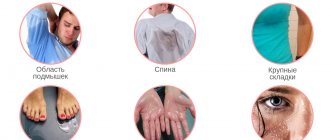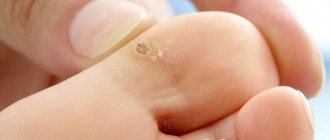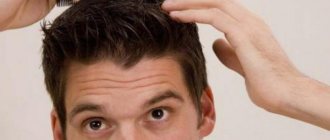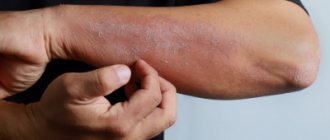Increased, excessive sweating in men: causes and treatment
It is worth saying that sweating is an absolutely natural physiological process. We are talking about hyperhidrosis when sweat is produced so intensely that it prevents a person from feeling comfortable in everyday life.
- The reasons for excessive sweating can be different:
- Features of a particular person;
- Wearing clothes and shoes made of low-quality, non-breathable materials;
- High ambient temperature;
- Disturbances and changes in the functioning of the body.
The last point requires special attention. It is also important to find the cause and treatment if a man is bothered by severe sweating all over the body, which occurs suddenly or in the case when hyperhidrosis of any area is accompanied by other symptoms.
Most often, the active secretion of sweat in one or two zones is simply an individual feature that requires adjustment only at the request of the person.
Malignant and benign tumors
The center of thermoregulation is the hypothalamus, and tumors of any nature in this area cause hyperhidrosis. Sweating especially increases at night, regardless of the temperature in the room.
If this happens without explanation, then the following diseases can be assumed:
- histiocytic lymphoma (malignant lesion of lymphoid tissues);
- lymphocytic lymphoma (oncological damage to the lymph nodes);
- mixed lymphoma (complex cancer of the lymph nodes);
- Burkitt's lymphoma (malignant tumor of the jaw).
Oncological neoplasms are accompanied not only by hyperhidrosis, but also by sudden weight loss, sleep disturbances, general weakness and fatigue.
Excessive sweating after bronchitis in men: causes and treatment
Bronchitis is an infectious disease characterized by increased skin moisture. Active sweating is a symptom of intoxication (pathogenic microorganisms, pathogens, affect changes in the functioning of the body). So this is an absolutely normal reaction: sweating controls thermoregulation, and toxic substances are also eliminated through sweat.
If increased sweating bothers a man even after an illness, then two options are possible:
- Hyperhidrosis is a residual phenomenon - not all toxins are completely eliminated from the body. The sweating will soon stop.
- The disease has not stopped, and symptoms may worsen. Or hyperhidosis acts as a complication that can be corrected.
Indications and contraindications for botulinum therapy
Botox injections are often used to treat sweating in men.
Indications
The indication for the procedure is primarily a person’s personal discomfort associated with overly active sweat production. It can disturb almost any area of the body (armpits, feet, palms, head, back, etc.), causing physical and psychological discomfort.
The physical ones are associated with the selection of clothes, the need to wash more often than required (and this is not always possible), and the appearance of diaper rash. And the psychological factors that influence a person’s desire to solve the problem of hyperhidrosis as soon as possible are associated with experiences of an unpleasant odor and embarrassment during communication.
If sweating is a symptom of any disease or disorder, you must first begin treatment for these diseases.
Contraindications to the treatment of hyperhidrosis with Botox in men
- Absolute contraindications to botulinum toxin injections:
- Myasthenia gravis (neuromuscular disease: pathological, rapid fatigue of striated muscles);
- Other neurological diseases;
- Blood diseases;
- Infectious and inflammatory processes in the armpits.
At the time of the botulinum therapy procedure, the man should not have an exacerbation of chronic diseases: this is due to the fact that the effect of the drug in this case will be low.
Preventive measures
To prevent hyperhidrosis, it is first necessary to exclude the development of somatic diseases and promptly treat chronic pathologies. To do this, you need to regularly visit a doctor for medical examination or prescribe treatment.
If excessive sweating is not a consequence of other diseases, you should adhere to the following measures:
- exclude spicy, hot dishes, spices, alcohol from the menu;
- stop smoking;
- take a contrast shower, warm baths with herbal decoctions (chamomile, oak bark);
- do not take medications without a doctor’s prescription;
- in clothing, give preference to natural fabrics (cotton, linen);
- shoes should be made of genuine leather or breathable materials with special moisture-absorbing insoles.
Article sources:
- Hyperhidrosis: method of correction. Batyrshina S.V., Khaertdinova L.A. Practical medicine No. 8, 2014. p. 16-23
- Hyperhidrosis and its impact on those living with it. Mary Lenefsky, 1Department of Dermatology, Emory University School of Medicine, Atlanta, GA, 2022.
- Pathophysiology and Treatment of Hyperhidrosis. Tomoko Fujimoto. 1Department of Dermatology, Graduate School of Medical and Dental Sciences, Tokyo Medical and Dental University, Tokyo, Japan. 2016
- Axillary hyperhidrosis: a focused review. Jason E Sammons, Amor Khachemoune. Department of Clinical Medicine, Avalon University School of Medicine, Willemstad, CW, USA. 2b SUNY Downstate and VA Medical Center, Brooklyn, NY, USA. 2017
Methods for solving the problem
Modern treatment methods are divided into two types - conservative and surgical.
Conservative physiotherapeutic methods of treatment include iontophoresis - an electric current generator that clogs the ducts of the sweat glands. However, it has little effectiveness for the treatment of, for example, axillary hyperhidrosis, especially severe. Iontophoresis is prescribed in a course, in each case this is an individual number of procedures.
Botox injections are rightfully considered one of the most effective ways to get rid of excessive sweating in men. The drug blocks the nerve endings that connect to the sweat glands. The amount of sweat produced is greatly reduced, and you can forget about the problem for more than six months. Then the procedure is repeated: naturally, if the patient wishes.
Surgical methods include curettage - excision of areas of hyperhidrosis, curettage of sweat glands. The operation is prescribed infrequently: there must be clear indications for it. It is performed if no other measures have brought the patient the desired result. The effect lasts from six months to several years.
You can find an approach to any problem. In the case of hyperhidrosis, there are also conservative measures that, if they do not completely get rid of the problem, will at least to some extent help improve the situation.
Necessary measures:
- Taking a shower in the morning and evening;
- Ventilate the room before going to bed, maintaining normal room temperature during the day;
- Sleeping on natural, high-quality bedding, wearing clothes made from natural fabrics;
- Use of antiperspirants.
How and why sweat occurs
The content of the article
When overheated, sweat glands begin to release fluid to the surface of the skin, thereby reducing body temperature. Water-salt balance is needed to maintain a constant level of electrolytes and ions in the intracellular fluid. Blood plasma also has a salt composition, but in a slightly different concentration.
The main regulator of sweating is the hypothalamus, a region of the brain that sends signals to various parts of the endocrine system, in particular the sweat glands.
Thus, with an increase in the concentration of salts in the blood plasma and a decrease in the volume of intercellular fluid (workout, visiting a sauna, staying in the sun), the signal is processed by the hypothalamus, which reacts by creating a feeling of thirst.
When body temperature rises, regardless of whether it is external influence (overheating) or internal processes (fever), thermoreceptors reflexively react to this and signal the hypothalamus. It activates the work of more than 2.5 million sweat glands, and they begin to secrete sweat-fat secretion.
Botox therapy
Initially, botulinum toxins were created to eliminate the consequences of strokes and neuritis in patients. Then botulinum toxin migrated to cosmetology: due to the relaxing effect it has on muscle tissue, botulinum toxin began to be used in the fight against wrinkles “from the inside.”
It should also be noted that the botulinum toxin injection procedure is safe - they do not affect the lymph nodes, blood vessels, muscles, but only combat the problem of increased sweating. However, for your own safety, you need to remember that the doctor must be a qualified specialist, and the clinic must have permission to work with this type of drug, issued by the manufacturer.
Contrary to popular belief, drugs from different companies do not differ from each other in terms of validity. More precisely, an adequate comparison of drugs is impossible, since they all have different concentrations of the substance and dosage methods.
There are no clear instructions on the dosage of the drug - the doctor relies on his own experience and developed standards. The procedure is slightly painful, so it is possible to use local anesthetics, for example, lidocaine cream. The duration of the procedure does not exceed 30 minutes.
First, the Minor test or iodine-starch test is performed, which allows identifying areas of the most increased sweating.
Cost of eliminating sweating in men
| Name | Price |
| Primary appointment (examination, consultation) with a cosmetologist | 1,500 rub. |
| Treatment for sweaty palms | 400 rubles/unit |
| Treatment of sweaty feet | 400 rubles/unit |
| Treatment for armpit sweating | 400 rubles/unit |
| Treatment of sweating of the head (face) | 400 rubles/unit |
| Treatment of other sweating (perineum, folds under the breasts, etc.) | 400 rubles/unit |
| Treatment of sweating underarms, palms and feet with Botox | 400 rubles/unit |
| Curettage | 55,000 rub. |
Excessive underarm sweating in men: causes and treatment
Many men experience wet spots on clothes and an unpleasant odor in the armpits. If there are no health problems, a man prefers natural fabrics in clothes, takes a shower, then this is simply an individual characteristic of a particular person, in which there is nothing serious. But it can be solved for a fairly long period of time with the help of a modern botulinum therapy procedure, at an appointment with a cosmetologist, in just 15-20 minutes!
Botox is administered subcutaneously: the sweat glands are located directly in the skin and the drug cannot be injected deeply, otherwise the drug will go into completely different tissues. The appearance of papules after the procedure means that the drug is in the right place. Within half an hour they will resolve, and after a few days the man will feel the effect of the procedure.
Thin needles (as for mesotherapy) virtually eliminate pain. Basically, the emphasis when administering the drug is on the middle part of the armpit. Sweating after the procedure usually appears gradually. Most often, the effect lasts for 6-8 months or more.
Curettage in the treatment of excessive sweating of the armpits in men is prescribed when other measures are ineffective or do not bring any result at all. Scraping of sweat glands is a surgical operation; there must be clear indications for it and no contraindications.
Diagnostics
The primary diagnostic search for excessive sweating is carried out by a general practitioner or general practitioner. The main objective of the examination is to identify disturbances in the functioning of the body that provoked changes in the functioning of the sweat glands. For this purpose, special functional tests, laboratory tests and instrumental visualization methods are prescribed. The most valuable for diagnosis are:
- Quantitative and qualitative tests
. To determine the degree of excessive sweating, a gravimetric method is useful, which involves weighing a piece of filter paper after 1 minute of contact with the skin. To measure the area of hyperhidrosis, the Minor test is used. Verification of the primary form of increased sweating is carried out using the chromatographic method. - Laboratory research
. The levels of the main hormones are measured - corticosteroids, thyroxine, tropic substances of the pituitary gland. Women must be tested for estrogen and progesterone levels. To exclude diabetes mellitus, fasting glycemia is determined, and a glucose load test is prescribed according to indications. Blood tests look for signs of inflammatory and tumor processes. - Neurological examination
. The appearance of increased sweating is often associated with pathologies of the nervous system, so all patients are examined by a neurologist. In addition to physical examination and assessment of basic reflexes, EEG and ultrasonography of peripheral nerves are used. According to indications, CT and MRI of the brain are prescribed.
When organizing further examination, accompanying symptoms are taken into account: in case of signs of an infectious process, serological tests are performed; in autoimmune diseases, the levels of rheumatoid factor and other specific markers are measured. Some patients are recommended to undergo a psychiatric evaluation. To diagnose doubtful cases of excessive sweating, consult other specialists (dermatologist, infectious disease specialist, oncologist).
Antiperspirants reduce sweat production and neutralize unpleasant odors
Excessive sweating of the feet in men: treatment and causes
If a man’s feet sweat a lot, this brings him certain inconveniences: lack of comfort during the day (unpleasant odor, humidity), embarrassment and fear of taking off his shoes when visiting. The reason may be the individual characteristics of the body, and coping with the problem will not be difficult. However, if hyperhidrosis occurs suddenly, and it did not exist before, or sweating is increased throughout the body, then it is worth checking with a specialist.
Botox injections are one of the best ways to combat hyperhidrosis. A simple procedure will allow you to forget about increased sweating for several months.
By the way, the quality of shoes greatly affects the production of sweat. If it is made of non-natural materials, does not fit in size, rubs, sweat is released more actively.
Increased, severe sweating of the head in men
Treatment for sweating of the head in men begins with a visit to a therapist and various conservative measures. For example, it is necessary to ventilate the room before going to bed, sleep on a pillow with a pillowcase made of natural materials, pay attention to the quality of your headdress, and pay sufficient attention to hygiene.
Perhaps during the consultation, the doctor will write out a referral to specialized specialists and recommend medications and folk remedies. A healthy assessment of the body’s condition will help to identify possible disturbances in the body’s functioning and successfully correct them.
Sweating in the groin in men: treatment
Perineal sweating in men is quite common. This is due to the peculiarities of this zone: apocrine glands are located here, secreting thick and odorous sweat; in the zone there is usually strong vegetation, which also contributes to the appearance of excess moisture and an unpleasant odor.
If the problem occurs periodically and does not bother you much, there is nothing wrong with it: it is enough to pay attention to hygiene. For example, it is best to take a shower both in the morning and in the evening. And during the day, natural underwear and normal ambient temperature will help maintain the comfort of the intimate area. Hair removal (shaving) in the perineal area partially helps solve the problem.
If groin hyperhidrosis is severe and bothers a man, he develops irritation and diaper rash, then you can consult a cosmetologist who specializes in the treatment of perineal sweating in men.
Botulinum toxin injections are a quick and safe procedure. Botox blocks the sweat glands, and you can forget about the disturbing problem for 6-8 months.
Other correction methods
A qualified specialist studies the problem of profuse sweating and also conducts a study of the rate of sweat production. As a result, the following treatment methods may be offered:
- Botox. It involves the introduction of injections into the problem area with a special composition based on botulinum toxin, which helps block signals from the nervous system to the glands and reduces sweat production. Only an experienced specialist can correctly calculate the required dosage of the drug and the number of sessions depending on the severity of the disease and the general condition of the body. If the patient is highly sensitive, local anesthetics are used to make the procedure painless. In general, this method is safe and has a quick effect.
- Sympathectomy. The surgical method involves the destruction of sweat glands, and not blocking them, as is the case with Botox. Here it is possible to use a special medical brace, which compresses the nerve fibers and, if necessary or after a while, is removed. Or the operation is performed using electrical stimulation, relieving the patient of the problem. The specific treatment method is determined by the vascular surgeon based on the results of the examination.
In both cases, the list of contraindications to the procedure is minimal; they also need to be clarified by a specialist.
Causes of night sweats in men: how to get rid of them, treatment
Men experience increased, severe sweating at night (during sleep): in order to find the causes and take action or begin treatment, you need to analyze your lifestyle and health status.
Nocturnal hyperhidrosis in the stronger sex can be affected by:
- Ambient humidity, poorly ventilated room, and as a result high air temperature;
- Sleeping on bedding made of synthetic materials, a blanket that is too warm;
- Wearing synthetic pajamas;
- Drinking alcohol, coffee, or difficult-to-digest foods at night;
- Any diseases, changes in the functioning of the body associated with age, health problems;
- Stress;
- Active sports before bed.
If a man has insomnia and sweating at night, the search for the cause and treatment should not be postponed: you need to visit a therapist who will refer you to specialist doctors, if necessary. A high-quality history and examination, tests and examination will help to find the cause and select treatment measures.
In any case, special attention to hygiene, clothing, a healthy diet, and regular ventilation of the room will help improve the condition.
Sweating is often the first symptom of a serious illness. In medicine, it is known under the term “hyperhidrosis”, and is characterized by impaired function of the sweating system. Hormonal disorders, endocrine and infectious diseases are often accompanied by excessive sweating. It is necessary to consult a doctor and find out what disease was the source of excessive sweating.
What types of hyperhidrosis are there?
With hyperhidrosis, different localization of the pathological process is noted. Taking this criterion into account, 2 types of sweating are distinguished:
- Generalized. Profuse sweat appears on all parts of the body; the patient experiences increased sweating of the face, neck and head. Generalized hyperhidrosis is characteristic of various diseases; it is never an independent disorder.
- Local. With this type of hyperhidrosis, the legs, arms, palms, feet and other individual parts of the body sweat. Local hyperhidrosis often occurs as an independent disease.
Diseases that cause sweating and additional symptoms
If sweating is observed in various diseases, doctors talk about secondary hyperhidrosis. To eliminate it, it is necessary to directly influence the underlying disease. Sweating occurs against the background of infectious infections, tuberculosis, and endocrine pathologies. Also, increased sweating may occur due to drug therapy, in which case a change in drug is required.
Endocrine diseases that cause severe sweating
Most often, severe sweating is caused by impaired function of the endocrine system. Diabetes mellitus is the most common source of sweating during the day and night. In type 1 and type 2 diabetes, it manifests itself in 3 forms, presented in the table:
| Form of sweating in diabetes | Features of manifestation |
| Unfounded | Sweating is not associated with any pathological manifestations |
| Not accompanied by high temperature or fever | |
| Flavoring | Appears after consuming a product |
| Only sweating of the face and neck is observed | |
| Night | Caused by a decrease in insulin levels at night |
Other diseases of the endocrine system can also affect excessive sweating:
- Acromegaly. The disease is characterized by the formation of a benign formation in the pituitary gland region of the brain. A person with acromegaly, in addition to increased sweat production, will experience signs of disproportionate growth of muscles and bones.
- Menopause period. In women, menopause often occurs with increased sweating. More than half of menopausal women suffer from this symptom. The problem is caused by abnormal levels of estrogen in the body.
- Thyrotoxicosis. With this disease, there is increased production of thyroid hormones. Additional symptoms appear more clearly in the later stages of the disease.
Infectious diseases are the main source of sweating
This symptom often indicates that an infection has entered the human body. Increased sweat production is caused by the following infectious diseases:
- Tuberculosis. In addition to increased sweating, the patient will be bothered by a cough with expectoration of blood, high fever, and soreness in the sternum. Particularly increased sweating occurs at night during sleep.
- ARVI. Acute respiratory viral infections accompanied by fever often cause the patient to sweat excessively.
- Inflammation of the bronchi. With bronchitis, a person constantly has a high temperature, which becomes a source of increased sweating.
- Malarial infection. When the disease occurs, symptoms such as fever, cold sweat, and chilly feeling appear.
- Purulent processes, including syphilis. With the latter, nerve fibers are damaged, which provokes impaired function of the sweating system.
Increased sweating is the first sign of a tumor
Sometimes excessive sweating is the first sign of a malignant or benign tumor in the body.
Acute intoxication of the body
If severe poisoning by chemicals or toxic substances is detected, the patient will be bothered by the following symptoms:
- swelling;
- high blood pressure;
- increased heartbeat;
- excessive sweating.
This condition is observed in patients with excessive consumption of caffeine, abuse of cocaine, alcohol and certain medications. When taking certain medications, the sympathetic nervous system is stimulated, resulting in increased sweating. A patient with excessive sweating due to intoxication requires emergency care.
Physician-therapist Boyko E.A.









